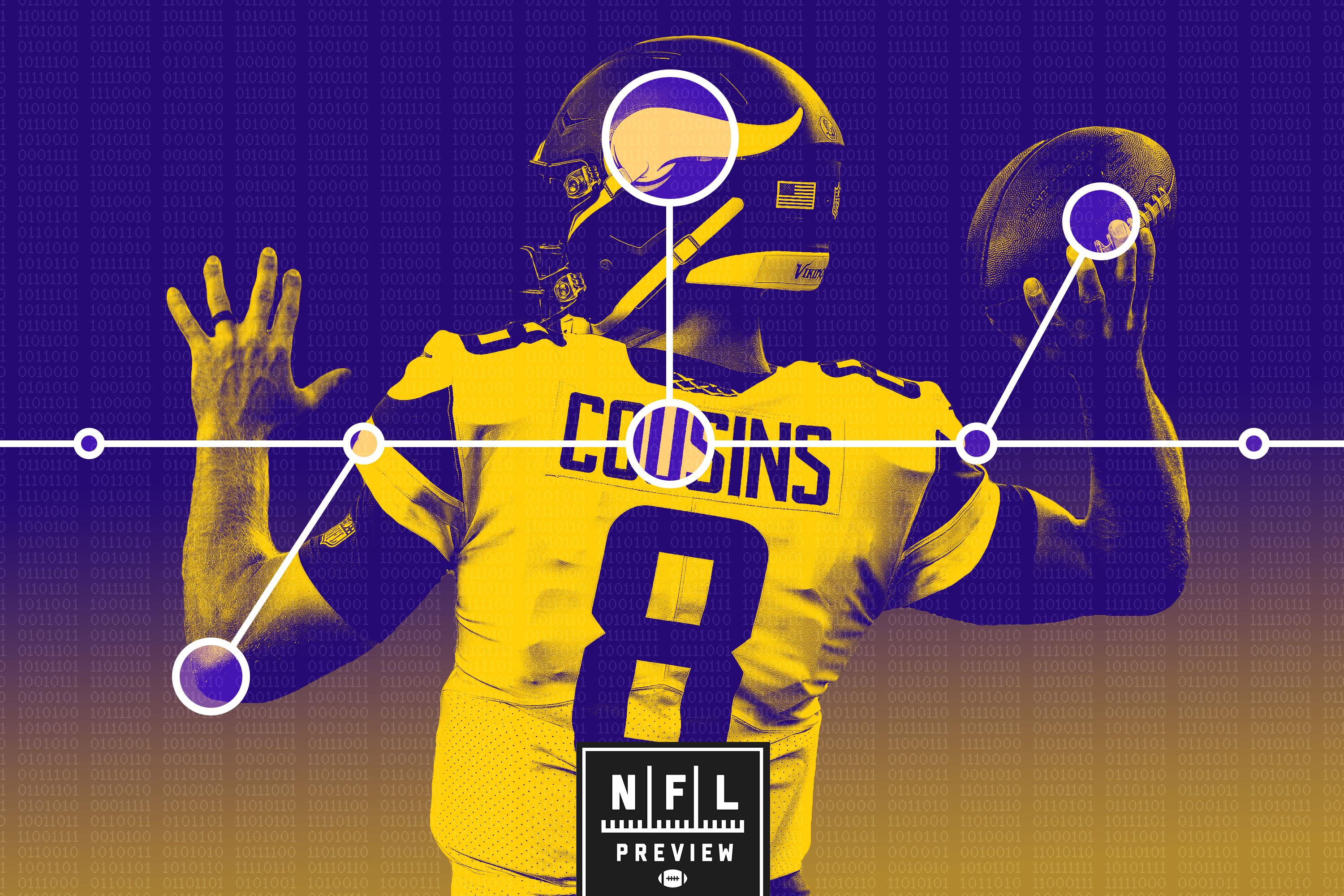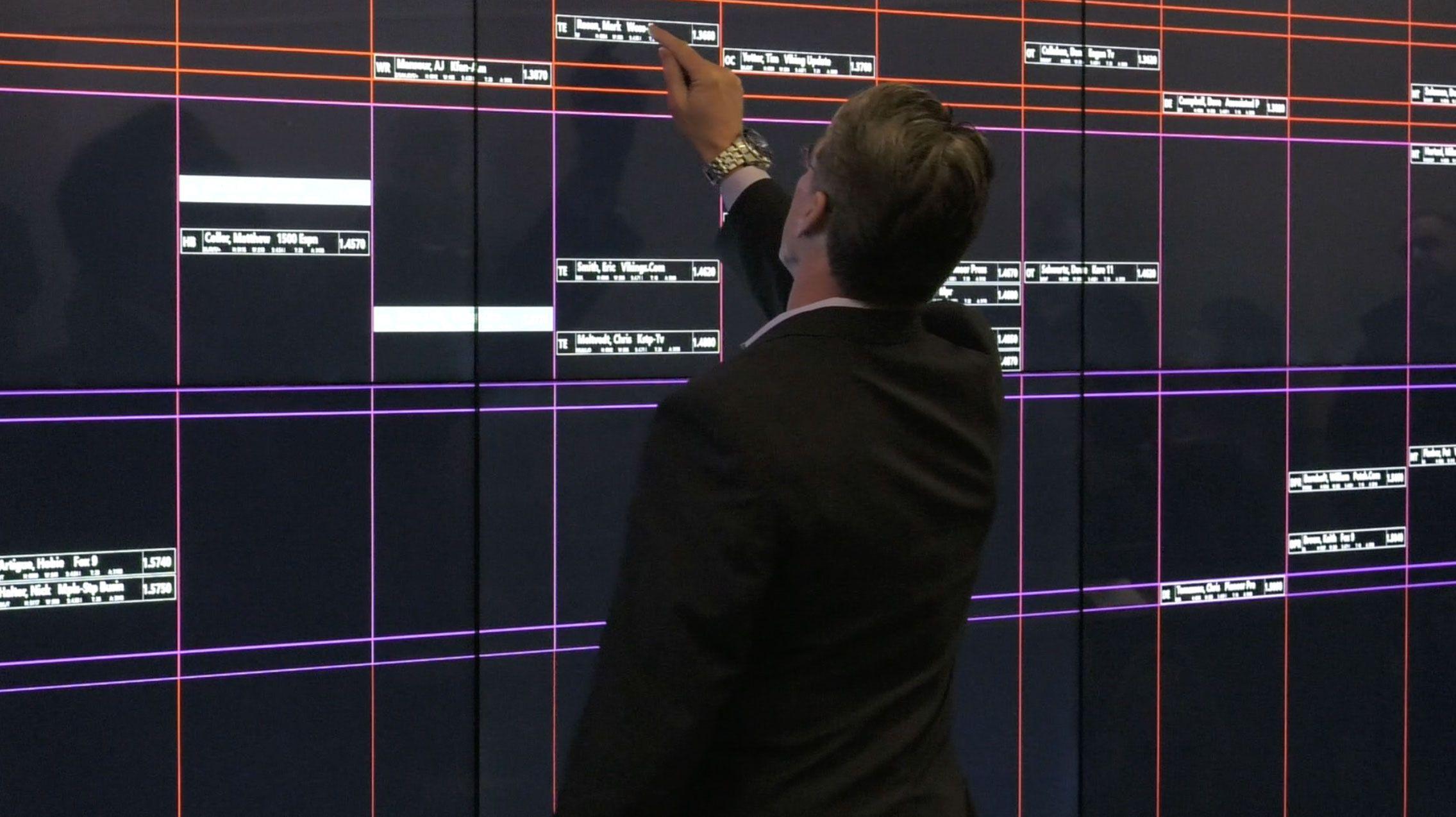
Forget the “stats are for losers” talk. Football’s analytics revolution is upon us. We’re spending today exploring how a deeper understanding of data is changing the sport—and the way fans consume it.
Earlier in training camp, in a conversation I had with an NFL team executive and a couple of other people, someone brought up the Minnesota Vikings’ new facility and, specifically, their new draft board. It’s digital and contains mountains of data and game tape—all available at the touch of a finger. Most notably, it does not include the league’s traditional organizational workhorse: the magnet.
“Wait, no magnets?” the exec said with some disbelief. The conversation moved on, we all started talking about something else, and the exec interrupted with even more disbelief this time.
“So wait, no magnets at all?”
No magnets. Really.
Even the smallest innovations can seem like revolutions in the NFL, so even the Vikings themselves felt weird about ditching magnets. “For as long as I’ve been in this business, we’ve used magnets. I was very wary about [the change],” said Minnesota general manager Rick Spielman. Away with magnets, and into the future.
What’s most notable about the Vikings’ new practice facility is how big of a role technology and analytics played in its construction. Now, the Vikings are certainly not the first team to embrace technology, nor are they the first team to use analytics. The Philadelphia Eagles just won the Super Bowl using analytics. The Jacksonville Jaguars’ analytics department has been useful for half a decade. The New England Patriots have used some form of analytics for years, even if Bill Belichick pretends to think the MIT Sloan Conference happens at Northeastern.
But the Vikings are the first team to build multiple rooms in a new facility specifically devoted to these things. It is impossible to overstate how much football will change over the next decade with more widespread advancement and acceptance of technology and analytics. The Vikings, who made it to the NFC championship last season and added Kirk Cousins this offseason, are not going to win the Super Bowl because they have video boards, but they certainly won’t be left behind in an era when it’s easier than ever for that to be happen. I’m often deeply skeptical when it comes to football, but the Vikings facility is one of the very few buildings I would consider an actual competitive edge.

When the Vikings’ head of football information systems told the Star Tribune last month that no one had built a facility of this kind, he couched it by saying that it’s impossible to know exactly what every team is doing in a league that prizes secrecy. But it’s a good guess that the Vikings have the most technologically advanced facility in sports—at this moment. Along with the Star in Dallas, it’s likely set off an arms race to create the kinds of practice facilities long seen in college football.
Most NFL teams still practice in relatively spartan office parks. There’s the big stuff—a virtual reality room, an improved weight room, an underwater treadmill that can be moved up or down depending on how much body weight you want underwater—and then the smaller stuff, which includes hills at different inclines depending on what position group you play in and what you want to accomplish from running up a hill.
Despite producing $14 billion in revenue, the NFL can be an analog experience. Until recently, Spielman would sit on Pro-Football-Reference.com, clicking through the game-finder feature: “I’d be going through quarterback evaluations, looking at players and how they did with two minutes to go. That would take me two days. I’d hand-write it out. I’d use a calculator. Now I can ask for anything and have it in 10 minutes.”
It’s a great time to invest in technology if you’re a football team. The NFL has finally begun to release leaguewide player-tracking data, which will likely open up a new era of football analytics. Spielman said the team has been preparing for the release of that data for “four years,” over which period he started banking an analytics database. It is crucial to be ready for this analytics revolution, Spielman said. He’s most interested, when he gets the data, in breaking out individual numbers, like finding out which guys in the league run slower as the season goes on.
Spielman thinks having a four-year database of advanced statistics inside the building will now give the team the sample size it needs to capitalize on the numbers it’s been collecting. And they don’t only have player information. The Vikings have been charting the player projections of their evaluators at each position group, trying to figure out which combination of scouts and coaches they should listen to most closely when evaluating, say, a defensive back. “If you’ve got Scout A predicting he’s going to be [in the] Pro Bowl, Scout B said he’ll be an [undrafted] free agent, and scouts C and D saying he’s gonna be a solid backup, you can look at the history—every evaluation and the result of the evaluation—so when I go into the meeting and listen to everybody as a staff, off of all the data we collect, I can weigh that.”
What NFL teams need is efficiency. And that, Spielman said, is the key to the entire technology push. “There are a zillion points of data. Data everywhere—combine numbers, psychological scores, three or four different intelligence scores, the reports we write. All the statistical information,” he said. “So what we have now, by the technology, is the ability to drill down into the information, to know what it means immediately. It makes it so much more efficient. You don’t waste as much time doing busywork, so you do meetings and evaluations.”
He gave me an example: Minnesota’s draft computers will start with 700 names. “I eliminated about half of them based on the technology. A little bit with our analytics, we see there are guys with less than a 5 percent chance of making a practice squad,” Spielman said. Under an older NFL system, he said, teams would spend more time on an individual report, often simply because a scout visited a school and felt the need to file a report on a player because he was there, not because the player was particularly talented. “So now, you get the data and you go, ‘OK, we need to look at this guy more.’ Or it says, ‘OK, this is not worth our time,’ because the data gives us percentages on which ones to home in on.”
In the past, Spielman said, when something “truly mattered, it was, ‘OK, let’s take a two-hour break from the meeting to come up with this [number], and then we get to talk about it.’”
The new technology means the end of busywork. And in the NFL, busywork can be complicated.
During the summer of 2016, I asked the exact question the Vikings are attempting to answer now: What do you do when hours upon hours of your day are suddenly freed up? The answer I got most often from teams was, “We don’t know.” Officials inside the league said that some teams didn’t want to know because all of the busywork, they felt, was a type of job training for younger coaches that should never be replaced.
Spielman, however, had a ready-made answer for what you can do with the extra time. On the coaching side, he said you can spend more time studying “special plays”—such as a trick play. Then you can view more film and draw the conclusions that come with that. “It expands your library of what you’re watching, because instead of the past three games, you can do whole-season stuff. You can go back two years, three years,” he said. This, in turn, can make teams more schematically advanced. Either they can prepare for more things or they even view (and borrow) more plays from another team.
Spielman said that his coaching staff, including head coach Mike Zimmer, has seen the benefits of using data. “I remember when we hired Zim, the first thing he asked for was an overhead [projector]. I told our ops guys, ‘Well, we might have to go to Goodwill or somewhere to find an overhead. I don’t know if they still make overheads.’” The Vikings analytics team spends time briefing the coaching staff on different analytic scenarios—going for it on fourth down, two-point conversions—and all the relevant percentages associated with them. Most forward-thinking NFL franchises at this point are having those conversations.
Despite all of the data-driven advancements, Spielman said that all football decisions will always be a mixture of numbers and tape. Zimmer sometimes gets upset about numbers without context—say, a data point that shows that a player ran only 14 miles per hour to the ball. “He’ll say, ‘Maybe that’s because he was told to do contain on the backside and then close,’” Spielman said. “So you have to have knowledge on why he isn’t running fast, or else you’ll look at the numbers and say, ‘OK, he’s not running at maximum effort because he’s not close to top speed.’”
Spielman prefers most of his analytics team to have a proficiency in football. He has them sit in football meetings so that they’ll learn the “language” of football. Even though his top analytics chiefs are well versed in the “R-algorithm,” he said, they also know the sport: “You cannot take a guy who works at IBM and just bring him in. It’s two different languages. How’s he gonna write reports?” Even basic jargon—“COD,” for change of direction, Spielman gave as an example—can take a while to learn.
“Zim says that before you know it, we’re going to be coaching robots out there,” he said, “but you can’t ever underestimate the human element.”
So, the human element and the unprecedented devotion to technology are combining this summer. The busywork is ending, the efficiency era is beginning, and we’re about to find out how that translates to the football field.
